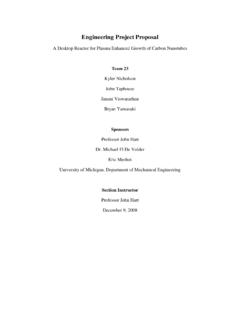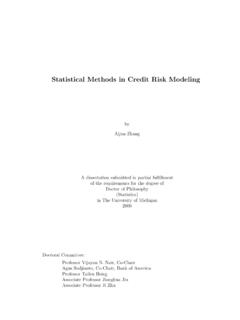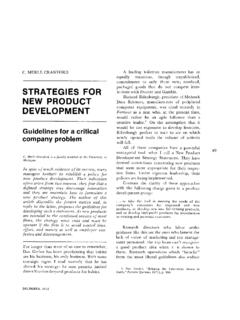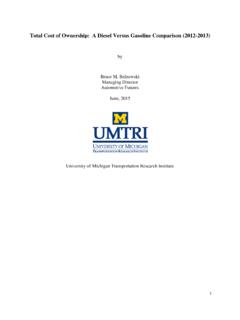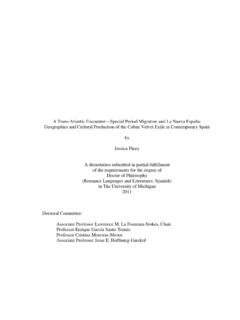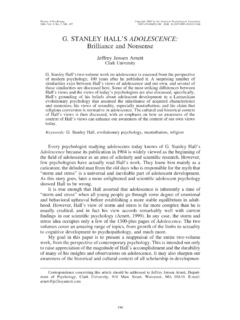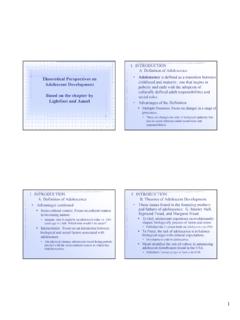Transcription of The passage to adulthood: Challenges of late adolescence
1 NEW DIRECTIONS FOR YOUTH DEVELOPMENT, NO. 111, FALL 2006 WILEY PERIODICALS, online in Wiley InterScience ( ) DOI: chapter outlines the major developmental chal-lenges likely to affect overall well-being during ado-lescence and emerging adulthood and discusses thepersonal and social assets needed to facilitate a success-ful passage through adolescence and into passage to adulthood : Challengesof late adolescenceNicole Zarrett, Jacquelynne EcclesTHERE ARE MAJOR developmental changes and Challenges associ-ated with the period of adolescence , as youth acquire and consoli-date the competencies, attitudes, values, and social capital necessaryto make a successful transition into adulthood . Late adolescenceand the period following, often referred to as emerging adulthood ,have been noted as particularly important for setting the stage forcontinued development through the life span as individuals beginto make choices and engage in a variety of activities that are influ-ential on the rest of their lives.
2 As youth move into emerging adult-hood around the age of eighteen (often on completion of highschool), their choices and Challenges shift to include decisions abouteducation or vocational training, entry into and transitions withinthe labor market, moving out of the family home, and sometimesmarriage and parenthood. Although early adolescence has receivedmuch attention by researchers as a period of major distress, recentlylate adolescence has become a period of concern among develop-mental researchers and youth directions for youth development DOI: YOUTH FOR THE CROSSINGD emographic, sociocultural, and labor market changes have madethe years between ages eighteen and twenty-five more transitionalthan in the recent past. Thirty years ago, the period of adolescencewas considered to end somewhere between ages eighteen andtwenty-two, at which point youth would choose between a small,easily understood set of options following high school: youth choseto move into college, the labor market, or the military and got mar-ried and had children during their early twenties.
3 These well-defined pathways from adolescence into adulthood no longer existfor most social class increased complexity and het-erogeneity in the passage into adulthood make the late adolescentperiod more challenging than in the past, especially for non-college-bound youth and members of several ethnic minority is essential to examine the influence of structural constraintson adolescents choices and engagement in activities that promotefuture options and opportunities and trajectories. It is also criticalto understand what assets and needs are essential for keeping youthon healthy, productive pathways into adulthood . As Erik Eriksonasserted, tasks of adolescence are played out in a complex set ofsocial contexts and in both cultural and historical developmental tasks of adolescence that Erikson outlinedinclude the development of a sense of mastery, identity, and inti-macy.
4 Others have added the establishment of autonomy, manage-ment of sexuality and intimacy, and finding a niche for oneself ineducation and Eccles and Gootman elaborated on thesetasks, identifying several more specific Challenges : (1) shifts in rela-tionship with parents from dependency and subordination to onethat reflects the adolescent s increasing maturity and responsibili-ties in the family and the community, (2) the exploration of newroles (both social and sexual), (3) the experience of intimate part-nerships, (4) identity formation at both the social and personal lev-els, (5) planning one s future and taking the necessary steps tonew directions for youth development DOI: passage TO adulthood pursue those plans, and (6) acquiring the range of skills and valuesneeded to make a successful transition into adulthood (includingwork, partnership, parenting, and citizenship).By emerging adulthood , youth are increasingly independent,acquire and manage greater responsibility, and take on an active rolein their own development.
5 Eccles and Gootman go on to specifysome primary Challenges in this last stage of adolescence whenyouth begin to take on more demanding roles: (1) the managementof these demanding roles, (2) identifying personal strengths andweaknesses and refining skills to coordinate and succeed in theseroles, (3) finding meaning and purpose in the roles acquired, and(4) assessing and making necessary life changes and coping with thesechanges. Successful management of all these Challenges depends onthe psychosocial, physical, and cognitive assets of the individual; thesocial supports available; and the developmental settings in whichyoung people can explore and interact with these and biological changesDuring early adolescence , youth experience dramatic changes in theshape of their bodies, an increase in gonadal hormones, and changesin brain architecture. Another major biological change during thisperiod between puberty and young adulthood is in the frontal lobesof the brain, responsible for such functions as self-control, judgment,emotional regulation, organization, and changesin turn fuel major shifts in adolescents physical and cognitive capac-ities and their social and achievement-related needs.
6 During earlyadolescence, the primary task consists of managing these biologicaland cognitive shifts and the subsequent influences these have onbehavior, mood, and social relationships. How youth cope with thesechanges will ultimately influence their well-being in later adoles-cence as multiple additional tasks are imposed on developmentCognitive skill development over the adolescent years enablesyouth to become increasingly capable of managing their ownlearning and problem solving while also facilitating their identity16 PREPARING YOUTH FOR THE CROSSINGnew directions for youth development DOI: and maturation of moral reasoning. There are distinctincreases in adolescents capacities to think abstractly, considermultiple dimensions of problems, process information and stim-uli more efficiently, and reflect on the self and life successful development of these cognitive skills relates toyouth s ability to be planful, an important skill for successful pursuit ofeducational and occupational has also been linked with ado-lescents greater investments in understanding their own and others internal psychological states and the resulting behavioral shift in focuson their developing close and intimate friendships.
7 As young peopleconsider what possibilities are available to them, they are more capa-ble of reflecting on their own abilities, interests, desires, and , youth are able to come to a deeper understanding of thesocial and cultural settings in which they live. In fact, research hasfound an increase in youth s commitments to civic involvement whensuch cognitive developments are coupled with prosocial values andopportunities to think and discuss issues of tolerance and humaninteraction with others. In a culture that stresses personal choice inlife planning, these concerns and interests set the stage for personaland social identity formation and ultimately influence educational,occupational, recreational, and marital and family of the key milestones for older youth is graduation fromhigh schoolFor some youth, adolescence continues to be a time for continued edu-cational growth and success and promising goals and plans for thefuture.
8 For others, adolescence is marked by major declines in aca-demic performance, interest, and self-perceptions of ability and height-ened risk for academic failure and dropout. Some researchers suggestthat these declines are due to an intrapsychic upheaval as youth strug-gle to manage the simultaneous occurrence of multiple life passage TO ADULTHOODnew directions for youth development DOI: research has found that academic declines in interest andself-concept are a function of the mismatch between the school envi-ronment and the adolescent. Person-environment fit theory outlineshow behavior, motivation, and mental health are influenced by thefit between the characteristics that individuals bring to their envi-ronments and characteristics of the environments themselves:whether individuals will fare well and be motivated dependson whether the social environment meets their needs.
9 When schoolenvironments do not meet adolescents changing needs, their aca-demic motivation, interest, and performance will decline. Difficul-ties in early adolescence , with the transition into middle school, seemespecially harmful, setting some youth on a downward spiral of lowacademic motivation and achievement throughout high addition, in all Western societies, one of the most universal fac-tors behind academic success throughout the entire educationalcareer is socioeconomic background. For the United States, there isample empirical evidence that socioeconomic status is the single bestpredictor of academic achievement from elementary school , Alfeld, Eccles, K ller, and Baumert found that childrenfrom lower socioeconomic strata are not only less successful in highschool, but they also have a significantly smaller empirical chance tomove into a four-year full-time college education even after control-ling for academic achievement and other psychological school continues to be an institution that provides youth asupport network for positive development through emerging adult-hood.
10 However, youth first need confidence in their abilities, goodsocial skills, high self-esteem, and good coping skills to manage themultiple Challenges and stressors associated with the high schoolenvironment in order to gain the experiences and resources neededto pursue postsecondary to collegeAt completion of high school, about half of America s youth enrollin college, and the remaining half move into a variety of work andnonwork difference in transitional trajectoriesinvolves very different experiences and Challenges for youth on the18 PREPARING YOUTH FOR THE CROSSINGnew directions for youth development DOI: tracks. Universities serve as social institutions that pro-vide youth shelter, organized activities, adult and peer support,health care, and a various forms of entertainment. College-boundyouth discover new-found independence: the college environmentenables them to practice self-governance, individuation from par-ents, and freedom to direct their own lifestyle in a safe environmentthat delays many adult a result, college-boundyouth have the opportunity to extend exploration of the self,develop new ideas, take advantage of multiple opportunities, andtry out various In essence, universities are social insti-tutions that have become increasingly tailored to provide a sort ofsemiautonomy to assist the transition into young a college education has become increasingly importantfor ensuring a bright future, the transition into and persistence in col-lege can be challenging and stressful.
